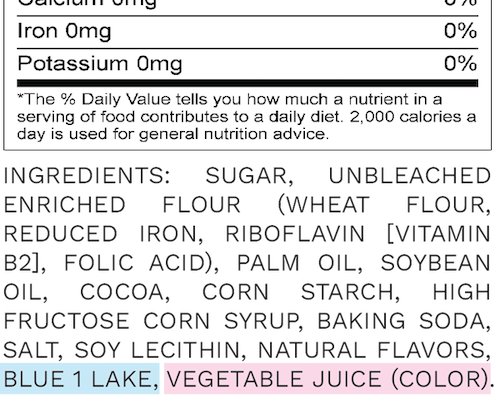While some believe that the Food and Drug Administration (FDA) of the United States has a more lenient approach to regulation than agencies in other regions, notably the European Union, when it comes to color additives the FDA is pretty specific. If the chief purpose of an additive is to change the color of food, then the additive is considered a color. If the purpose of the ingredient is something else, like flavor, then any color imparted must be clearly unimportant to appearance.
Any color additive must be approved for use in food by the FDA. There are two categories of color additives permitted in the US. These are listed in 21 Code of Federal Regulations (21CFR) Parts 73-82: certified color additives and exempt-from-certification color additives. The latter are commonly referred to as “natural” colors and the former are the synthetic or FD&C colors. Technically, the FDA considers all color additives “artificial” whether they originate from natural sources or are synthetic.
For certified colors, all manufacturers submit a sample of each batch for certification testing to the FDA, where the testing process determines whether the batch meets the color’s requirement for composition and purity. Once the batch is approved, the FDA issues a certified lot number and the manufacturer is permitted to sell the product. Colors subject to certification include:
Exempt from certification colors are primarily natural colors derived from plant, animal, or mineral sources.
| Annatto extract | Grape skin extract |
| Astaxanthin | Paprika oleoresin |
| Beet juice | Riboflavin |
| Beta carotene | Saffron |
| Beta-apo-8’ caroteneal | Sodium copper chlorophyll |
| Canthanxanthin | Spirulina extract |
| Caramel | Synthetic iron oxide |
| Carmine/Cochineal | Titanium dioxide |
| Dehydrated beets (beet powder) | Tomato lycopene |
| Fruit juice | Turmeric oleoresin |
| Grape color extract |
In recent years, several new exempt colors have been added to the US FDA approval list. These include Butterfly Pea Flower Extract (2021) , Soy leghemoglobin (2019), and Jagua (genipin-glycine) blue (2023). Several other colors have had extensions in their uses during this period.
Natural colors are not subject to batch certification. However, they must meet the FDA requirements for identity, composition and purity. In addition, some of these additives are limited to certain classifications of food products or certain usage levels. But importantly, food color manufacturers, rather than the FDA, bear the responsibility for self-certifying these colors.

At Sensient, we understand the importance of this responsibility: safety is always the top priority, especially with food ingredients. We developed Certasure™, the color industry’s leading food safety program, in response to this need. Certasure™ guarantees that every batch of botanical raw materials entering our facilities are tested against the strictest standards every time. The Certasure™ shield is placed on the packaging of our botanically-sourced colors and captured in our TDS documentation as a reminder that customers can rely on the science of certainty when working with our colors.
In short, it’s a long road. The FDA provides Guidance for Industry for Color Additive Petitions. This process recommends the submission of Chemical and Technological Data for the new color additive. The Guidance refers to the Statutory and Regulatory Requirements, which include the identity of the color; physical, chemical and biological properties; toxicology; chemical specifications; manufacturing process; stability; uses and restrictions; analytical methods and estimate of probable exposure. This list is not exhaustive, but is indicative of the type and amount of data FDA requires.
Color Additive Petitions, or CAP’s, are required for all proposed new color additives, as well as any extension of the use of a currently approved color additive. These petitions are several thousand pages long, and it can take petitioners several years to gather the required information depending on the toxicology and stability information needed.

Once a petitioner is prepared with the necessary data, it is recommended a meeting is set up with the FDA for initial review. If it goes well, the petitioner sends a petition to the US FDA, a CAP number is assigned, and the review of the data commences. Petitions for new additives typically runs three years, while those for extensions typically run one to two years. You can check on the status of any petition— either “under review” or “held in abeyance”—on the FDA’s website.
“Under review” indicates the FDA is actively reviewing the information and may be in correspondence with the petitioner for additional information. “Held in abeyance” is essentially a pause in the process, indicating the FDA has questions about the petition, and the petitioner has asked FDA to stop the review while they gather additional information.
We often receive requests from customers for GRAS (Generally Recognized as Safe) statements for color additives. The GRAS process is an affirmation notification by the petitioner of common food ingredients, to assert the additive’s safety. The GRAS notification process is not an allowable avenue for approved color additives. In GRAS response letters, FDA even recognizes the potential for a GRAS additive to be used as a color. As such, they state the additive needs to undergo the CAP process unless “any color imparted is clearly unimportant” to the ingredient and its value overall.
In the U.S., the FDA mandates that all color additives be labeled in the ingredient statement. Certified colors are declared by their name, such as “Yellow 5 (color)” or “Color (Blue 1 Lake.)”
Exempt from certification colors can be listed as “Colored with Vegetable/Fruit Juice, Vegetable/Fruit Juice for Color, or Color (Vegetable/Fruit Juice).”
Note that cochineal extract and carmine are the two exempt colors that require declaration by name. Please refer to 21 CFR 101.22(k) for additional labeling details.

Use of the term “natural color” is prohibited on an ingredient statement because, regardless of the source of the color. As we mentioned earlier, FDA regulations do not consider any added color to be natural unless the color is “natural to” the food product itself, such as coloring strawberry ice cream with strawberry juice. These are the regulations, at least for now! As most of you know, FDA regulations can sometimes change very quickly.
If you have questions about food color and the FDA, reach out to me! My team and I are tuned in to the latest regulatory updates in North America and around the world, and we’re always happy to help.